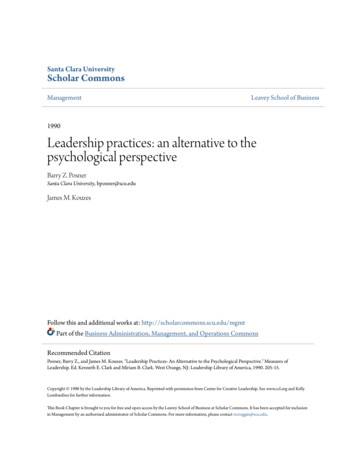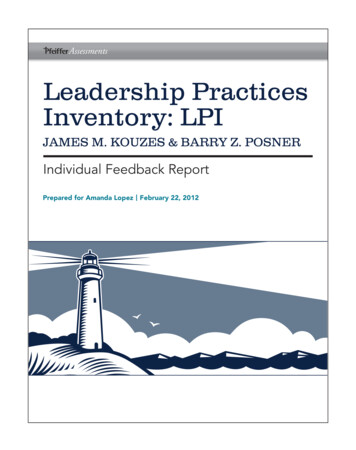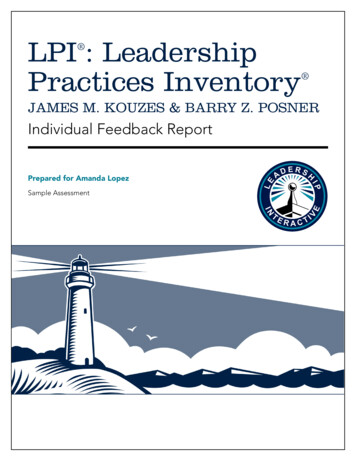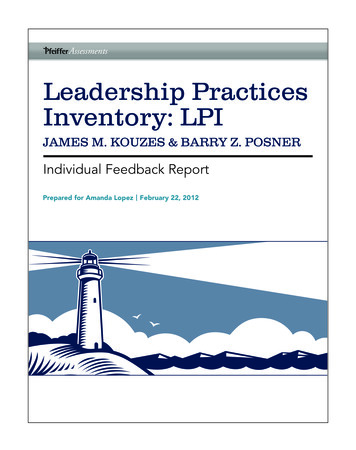
Transcription
Santa Clara UniversityScholar CommonsManagementLeavey School of Business1990Leadership practices: an alternative to thepsychological perspectiveBarry Z. PosnerSanta Clara University, bposner@scu.eduJames M. KouzesFollow this and additional works at: http://scholarcommons.scu.edu/mgmtPart of the Business Administration, Management, and Operations CommonsRecommended CitationPosner, Barry Z., and James M. Kouzes. "Leadership Practices: An Alternative to the Psychological Perspective." Measures ofLeadership. Ed. Kenneth E. Clark and Miriam B. Clark. West Orange, NJ: Leadership Library of America, 1990. 205-15.Copyright 1990 by the Leadership Library of America. Reprinted with permission from Center for Creative Leadership. See www.ccl.org and KellyLombardino for further information.This Book Chapter is brought to you for free and open access by the Leavey School of Business at Scholar Commons. It has been accepted for inclusionin Management by an authorized administrator of Scholar Commons. For more information, please contact rscroggin@scu.edu.
Leadership Practices:An Alternative tothe PsychologicalPerspectiveBarry Z.PosnerandJamesM.KouzesA timeworn debate over whether leaders are made or bornlies at the heart of a search for the mystical psychologicalcharacteristics which separate leaders from the rest of thepopulation. If leaders are born and not made, then theanswer to the question "Can leadership be taught?" is moot.Our glib response to this question is that all leaders aredefinitely born. We have little if any concrete evidence to thecontrary. But the only honest answer to this question ofwhether leaders are made or born must be "no one knows forsure."We strongly believe, however, that leadership is a skill andlike any other talent is distributed normally in the population.Clearly, some individuals have a higher probability of succeeding at leadership than others. But even in the mostcomprehensive and conscientious longitudinal studies of executive progress (e.g., Bray & Howard, 1983), often morethan one-third of those not predicted to be were in factsuccessful as leaders. An alternative perspective on leadership shifts the focus away from the psychological characteristics of leaders themselves to what it is that people (managers,leaders, administrators, salespeople, politicians, homemakers, military officers, priests, scientists, teachers, carpenters,and so on) do when they are leading.A plethora of research studies on leadership has beenconducted over the past three decades (see, for example,Bass, 1981) . A host of recent books focus on leadership andleaders (e.g., Bass, 1985; Bennis & Nan us, 1985; Bradford& Cohen, 1984; Kotter, 1987; Leavitt, 1986; Levinson &Rosenthal, 1984; Peters & Austin, 1985; Tichy & Devanna,1986). Currently, the leadership research field is in transitionabout the essential behaviors of leaders, moving from earlierversions of initiating consideration and structure (Reishman,205
1953) and transactional leaders to what Burns (1978) has referred to as transformationalleadership . Still, the field lacks consensus around such issues as what leadership is, howit differs from management, and whether it can be measured or taught.Leaving aside these important arguments for the moment, there is ample evidenceof a viable construct called leadership and attempts to understand and measure thisphenomenon are worthwhile. In this paper we present first a brief review of ourqualitative efforts to develop a conceptual framework for understanding leadership.Described in more detail are the empirical efforts utilized in developing a reliable andvalid instrument to measure this leadership model. Stage One: Qualitative Perspective on What Leaders DoWe asked managers attending a variety of public and contract management development seminars to describe a "personal best as a leader" -an experience in which theygot something extraordinary accomplished in an organization . This was their personalbest experience as a leader. This was an experience in which they felt they had led,not managed, their project to plateaus beyond traditional expectations. These wereexperiences in which "everything came together."The personal best survey is 12 pages long and consists of 37 open-ended questions.Several sample questions include: Who initiated the project? What made you believeyou could accomplish the results you sought? What special, if any, techniques orstrategies did you use to get other people involved in the project? Did you do anythingto mark the completion of the project , at the end or along the way? What did you learnmost from the experience? What key lessons would you share with another personabout leadership from this experience? Completing the personal best survey generallyrequires about one to two hours of reflection and expression. More than 850 of thesesurveys have been collected. A short form (one to two pages) of the survey was alsodeveloped and has been completed by an additional450 managers.In addition to these case studies we conducted 38 in-depth interviews primarily withmanagers in middle- to senior-level organizational positions in a wide variety of publicand private sector companies. These interviews have generally taken 45- 60 minutes,but in some cases have lasted four or five hours. The various case studies (from surveysand interview notes) were content analyzed first by the authors and then validated bytwo separate outside raters. While the category labels have gone through severaliterations, the fundamental pattern of leadership behavior which emerges when peopleare accomplishing extraordinary things in organizations is best described by the followingfive practices, each of which consists of two basic strategies: A more complete explanation of the methodology and conceptual framework is available inour book The Leadership Challenge: How to Get Extraordinary Things Done in Organizations(San Francisco, CA: Jossey-Bass, 1987). Similarly, a more extensive psychometric report canbe found in "Development and Validation of the Leadership Practices Inventory," Educationaland Psychological Measurement (1 988), Vol48: 483-496.206 POSNER AND KOUZES
1) Challenging the Processa. Search for opportunitiesb. Experiment and take risks2) Inspiring a Shared Visiona. Envision the futureb. Enlist the support of others3) Enabling Others to Acta. Foster collaborationb. Strengthen others4) Modeling the Waya. Set the exampleb. Plan small wins5) Encouraging the Hearta. Recognize contributionsb. Celebrate accomplishmentsMore than 80 percent of the behavior and strategies described in respondents'personal best case studies and interviews can be accounted for by these factors. Whilethere may appear to be a somewhat linear or sequential flow to these practices the actualdynamics are more complex. In the course of personal best experiences individuals arelikely to describe an iterative, or developmental, flow to the leadership process. Theircases provided illustrative examples of the dynamic interconnectedness among thevarious behaviors and strategies.Stage Two: Measuring What Leaders DoThe Leadership Practices Inventory (LPI) was designed on the basis of lengthy andrepeated feedback from respondents, and factor analyses of various sets of behaviorallybased statements. Each statement was cast on a five-point Likert scale. A higher valuerepresented greater use of a leadership behavior: (1) Rarely or never do what isdescribed in the statement, (2) Once in a while do what is described, (3) Sometimes dowhat is described, (4) Fairly often do what is described, and (5) Very frequently, if notalways, do what is described in the statement. Sample statements include: "I seek outchallenging opportunities which test my skills and abilities." "I let others know my beliefson how to best run the organization I manage." "I treat others with dignity and respect."The LPI was originally completed by 120 MBA students. These students wereemployed full-time and attending school on a part-time basis at a small private WestCoast university. Their average age was 29 years, nearly 60 percent were males, andalmost half had supervisory experience. An item-by-item discussion was conductedafter the subjects completed the instrument. Difficult, ambiguous, or inconsistent itemswere either replaced or revised. Feedback discussions with nine professionals inpsychology, organizational behavior, and human resource management-familiar withpsychometric issues, the conceptual framework, and management development-further refined the inventory.LEADERSHIP PRACTICES 207
Successive administrations of the instrument in the early stages of developmentinvolved more than 2,100 managers and their subordinates. Analysis of data from theserespondents included tests of internal reliability and construct validation through evaluating the underlying factor structure (Kerlinger, 1973). Statements which loaded poorlyor on an uninterpretable factor were either discarded or rewritten . Additional discussionswith respondents resulted in further modification of the instrument.The outcome of the above procedures is the current form of the instrument, whichcontains 30 statements-six statements measuring each of the five leadership practices.There are two forms of the leadership Practices Inventory- Self and Other-whichdiffer only in whether the behavior described is that of the respondent's (Self) or is therespondent's behavior being described by a third party (Other) .SampleThe sample for the current version of the leadership Practices Inventory consists of2,876 managers and executives involved in several public and in-company management development seminars and their subordinates. For the lPI-Self there are 708respondents whose backgrounds represent a full array of functional fields from bothpublic and private sector organizations. Twenty-two percent are female. There areapproximately three subordinate respondents (lPI-Other) for each managerial subject(N 2, 168) . A separate sample of foreign managers was also collected, includingmanagers from Australia, England, Germany, and Holland . While no attempts havebeen made to generate "representative" sample populations of managers, the relativelylarge total sample size involved increases the potential generalizability of these findings.The .01 1evel was adopted throughout the analyses as the appropriate level of statisticalsignificance.Procedurally, individuals completing the lPI-Self also request four to five other peoplefamiliar with their behavior to complete the lPI-Other (although in some workshopsettings only the lPI-Self is completed) . The lPI-Other is voluntary and confidential.The form is returned directly to the researchers (or seminar facilitators) . The lPI-Selfcan be self-scored, but is typically returned directly to the researchers for scoring andfeedback purposes.ResultsMeans, Standard Deviations, and Reliability Means and standard deviationsfor each scale of the leadership Practices Inventory are represented in Table 1, as wellas the scores on various reliability measures. Enabling Others to Act was the leadershippractice most frequently being used. This was followed by Challenging the Process,Encouraging the Heart, and Modeling the Way. Inspiring a Shared Vision was theleadership practice perceived as least frequently engaged in by managers, althoughthere was the greatest amount of variance associated with this practice. The Leadership Practices Inventory Is available from University Associates (8517 ProductionAvenue, San Diego, CA 92121). Scholars Interested in utilizing the LPI in their research, ratherthan executive development programs, should contact the authors directly.208 POSNER AND KOUZES
TABLE 1Standard Deviations and Reliability Indicesfor the leadership Practices InventoryINTERNAL RELIABILITYMeanChallenging the ProcessInspiring a Shared VisionEnabling Others to ActModeling the WayEncouraging the Heart22.5320.0123.6822.3022.3 LPI-OtherTest-RetestReliabilityDesirability(N 2,876}(N 708)(N - 2,168)(N - 9.27.77.88.84.80.90.73.83.70.72.84SocialInternal reliabilities on the Leadership Practices Inventory ranged from . 77 to .90 ,with reliabilities ranging from . 70 to .84 on the LPI-Self to .81 to. 91 on the LPI-Other.Test-retest reliability from a convenience sample of 57 MBA students averaged nearly.94. These students were e mployed full-time and attending graduate school on apart-time basis . More than 50 percent had supervisory responsibility. Forty percentwere women.Tests for social desirability response bias using the Marlowe-Crowne Personal Reaction Inventory (Crowne & Marlowe, 1960) were .also conducted. This scale consists of33 ite ms representing behaviors that are culturally sanctioned and approved but areimprobable of occurrence. The sample involved 30 middle-level managers and noneof the correlations were statistically significant.Comparisons Between the LPI-Self and LPI-OtherTable 2 presents means and standard deviations for the five leadership practices onthe LPI-Self compared with those on the LPI-Othe r. Frequency scores on the LPI-Selfwere gene rally higher (p .001) than those on the LPI-Other for all five practices. Therelative rank ordering of the leadership practices on the LPI-Self was identical with therank ordering on the LPI-Other, and in agreement with the pattern observed in Table1. The variances for each of the leade rship practices were notably greater on theLPI-Other than the LPI-Self. On the LPI-Other there was considerable variance aboutthe Inspiring a Shared Vision practice, closely followed by Encouraging the Heart. Thissame configuration was found on the LPI-Self. Enabling Others to Act was reported bymanagers (LPI-Self) to be the p ractice they engaged in most frequently and there tendedto be conside rable agreement (low variance) among the m . Others, responding aboutthese managers, also reported this practice as most frequently e ngaged in but -t here wasconsiderably more disagreement among them. Inspiring a Shared Vision was theLEADERSHIP PRACTICES 209
TABLE 2T-Tests of Differences Between Scoreson the LPI-Self and LPI-Other*LPI-OTHERLPI-SELFChallenging the ProcessInspiring a Shared VisionEnabling Others to ActModeling the WayEncouraging the 6923.2222.0521.994.1 45.254.544.345.18*All two-tailed t-tests were statistically significant (p .001).practice both managers and their subordinates felt was least frequently engaged in ,although this practice showed the greatest variance on both the LPI-Self and LPI-Other.Factor Structure of the LPI The factor structure of the Leadership PracticesInventory is presented in Table 3. Responses to the 30 leadership be havior items werefactor analyzed, using principal factoring with iteration and varimax rotation. Theanalysis extracted five factors with eigenvalues greater than or equal to 1. 0 andaccounted for 59.9 percent of the variance. These factors were quite consistent with apriori expectations . The individ ual item factor loadings were also generally as expected.The stability of the five factors was tested by factor analyzing the data from differentsubsamples. In each case the factor structure was similar to the one shown in Table 3which involves the entire sample (N 2,876).Managerial Effectiveness and the Leadership Practices Inventory In additionto the creation of the Leadership Practices Inventory, a leadership effectiveness scalewas developed and included in the investigation with several samples. This measurealso went through several iterations in its development. It contained six Likert-typeitems on five-point scales. The questions asked about the extent to which this manager(the person who requested they complete the LPI) meets the job-related needs ofhis/her subordinates, has built a committed work group, and has influe nce with uppermanagement. Additional items gauge the extent to which the respondents are satisfiedwith the leadership provided by the manager, believe that the manager's leadershippractices are appropriate, and feel e mpowered by the manager. Coefficient alpha forthe leadership effectiveness scale was .98 . The test-retest reliability over te n days for asample of 57 MBA students was better than .96. The leader e ffectiveness scale wasfound , in a sample involving 30 middle-level managers, not to be significantly correlatedwith the Marlowe-Crowne social desirability measure.Utilizing only the responses from the LPI-Other (N 514), the relationship betweena leader's effectiveness and their behavior as measured on the Leadership Practices21 0 POSNER AND KOUZES
TABLE 3Factor Structure (Factor Loadings)for the Leadership Practices Inventory(N 2,876)FACTOR ersto ActEncouragingthe HeartInspiringa SharedVisionChallengingthe ProcessModelingthe .115
Inventory, was examined. Including only the responses from "other people" about themanager provided relatively independent assessments , thereby minimizing any potential self-report bias. Using stepwise regression analysis the five leadership factors/ practices were entered as the independent variables and leader effectiveness as thedependent variable. The results (not shown) revealed a highly significant regressionequation (F 318.9, p .0001) . The leadership practices model explained nearly 55percent (adjusted R .756) of the variance around subordinates' assessments of theirleaders' effectiveness.Another method for examining the validity of the Leadership Practices Inventory isto determine how well LPI scores can differentiate between high- and low-performingmanagers. This issue was investigated using discriminant analysis as a classificationtechnique. This assessment of predictive validity examined how well the LeadershipPractices Inventory could group managers into various performance-based categories.The lowest third and highest third of the managers on the LPI-Other leader effectiveness scale formed the low- and high-performance categories . Approximately 85percent of the sample of LPI-Other respondents (N 325) were used to create thecanonical discriminant function with the remaining responde nts (N 54) used to createa holdout sample for classification purposes. One discriminant function was derived.As shown in Table 4, the discriminant function correctly classified 92.62 percent of theknown cases . In the holdout sample 77 . 78percent of the cases were correctly classified .Both of these results are statistically significant (p .001) .TABLE 4Classification Results from Discriminant Analysis onEffectiveness by Leadership Practices Inventoryfor Two- and Three-Group CasesPERCENTAGECORRECTLOWHIGHKnown SampleActual MembersPredicted Members16915415614792.62Holdout SampleActual MembersPredicted Members2316312677.78TWO-GROUP CASETHREE-GROUP CASELOWMODERATEHIGHPERCENTAGECORRECTKnown SampleActual MembersPredicted Members1691231086415612171 .13Holdout SampleActual MembersPredicted Members23162716312367.90212 POSNER AND KOUZES
When the middle third of the sample (that is, managers with moderate effectivenessscores) was included, the discriminant functions derived were able to correctly classify71.13 percent of the cases in the known sample and 67.90 percent in the holdout sample(see Table 4). Both of these percentages are significantly beyond probabilities due tochance (p .001). That scores on the Leadership Practices Inventory are related tomanagerial (leader) effectiveness is reinforced by the classification results from thediscriminant analyses.ConclusionsThe Leadership Practices Inventory was developed to measure empirically theconceptual framework developed in the case studies of managers' personal best experiences as leaders-times when they had accomplished something extraordinary in anorganization. Various analyses suggest that the LPI has sound psychometric properties.The factor structure of the Leadership Practices Inventory is quite consistent with thea priori conceptual model. The internal reliabilities of the LPI (both Self and Otherforms) are substantial. The reliability of the LPI over time seems very good. Finally,the LPI does not seem to be significantly affected by possible social desirability responsebiases.There are differences between respondents' self scores and scores provided by othersabout the respondent (LPI-Self versus LPI-Other). In itself this is not a remarkablefinding because this same phenomenon is characteristic of many psychological inventories. Caution, however, should be exercised when interpreting the LPI-Self scoresindependent of LPI-Other feedback.For both feedback (self-development) and research purposes the LPI-Other appearsto provide relatively reliable and valid assessments of respondent behavior. More thanone-half of subordinates' evaluations of their managers' effectiveness can be explainedby their perceptions of the managers' behavior along the conceptual framework of theLeadership Practices Inventory. Moreover, significantly better-than-chance predictionsabout subordinates' assessments of their managers' effectiveness can be made basedupon information provided by the LPI. Research is currently under way to investigatehow the Leadership Practices Inventory is related to other independent measures ofmanagerial effectiveness.Returning to the initial question of whether or not leadership can be taught, it isinteresting to note that people seldom ask: "Can management be taught?" "Aremanagers born or made?" These questions are central to debates about leadership, yetare never raised about management. Why should manage ment be viewed as a set ofskills and abilities but leadership be seen as a set of innate personality characteristics? Ithas simply been assumed that management can be taught and on the basis of thatassumption hundreds of business schools and thousands of management courses havebeen established. Certainly some of these managers are better than others. However,on average, the caliber of managerial performance is undoubtedly better today thanyears ago because of the assumption that people can learn the attitudes, skills, andLEADERSHIP PRACTICES 213
knowledge associated with good management practice. Why should leadership education and development require a loftier or more genetically based set of assumptions?Preliminary research utilizing a pre- and posttest administration of the LPI suggeststhat leadership skills can be taught and/ or enhanced. Participants in a week-longleadership development program (conducted by AT&T) showed an average 15 percentincrease in leadership behaviors (as measured on the LPI-Other) ten months followingthe program. Qualitative analyses revealed even more dramatic changes in leadershippractices as reported to company officials by both participants and their subordinates.The search continues for specific psychological traits which predict leaders. We suggest,however, that a more fruitful approach is to examine and identify key behaviors ofleaders , how these behaviors manifest themselves, and how these practices can benurtured and developed in people.ReferencesBass, B. M. {1981). Stogdill's handbook of leadership: A survey of theory andresearch. New York: Free Press.Bass, B. M. (1985). Leadershipandperformancebeyondexpectations. NewYork:Free Press.Bennis, W., & Nanus, B. (1985) . Leaders: The strategies for taking charge. NewYork: Harper & Row.Bradford, D. L., & Cohen, A. R. (1984). Managing for excellence. New York: Wiley.Bray, D. W., & Howard, A. (1983). The AT&T longitudinal studies of managers. InK. W. Schaiel (Ed.) , Longitudinal studies of adult psychological development.New York: Guilford Press.Burns, J. M. {1978). Leadership. New York: Harper & Row.Crowne, D. P., & Marlowe, D. {1960). A new scale of social desirability independentof psychopathology. Journal of Consulting Psychology, 14, 349-354.Fleishman, E. A. (1953) . The description of supervisory behavior. Journal ofApplied Psychology, 37, 1-6.Kerlinger, F. N. (1973). Foundations of behavioral research (2nd ed.). New York:Holt, Rinehart, & Winston.Kotter, J. {1987). The leadership factor. New York: Free Press.Kouzes, J. M., & Posner, B. Z. (1987). The leadership challenge: How to getextraordinary things done in organizations. San Francisco, CA: Jossey-Bass.Leavitt, H. J. (1986). Corporate pathfinders. Homewood, IL: Dow Jones-Irwin.Levinson, H., & Rosenthal, S. (1984) . CEO: Corporate leadership in action. NewYork: Basic Books.214 POSNER AND KOUZES
Peters, T. J., & Austin, N. (1985). A passion for excellence. New York: RandomHouse.Tichy, N. M. & Devanna, M. AWiley.(1986). The transformational leader. New York:LEADERSHIP PRACTICES 215
leadership practice perceived as least frequently engaged in by managers, although there was the greatest amount of variance associated with this practice. The Leadership Practices Inventory Is available from University Associates (8517 Production Avenue, San Diego, CA 92121). Scholars Interested in utilizing the LPI in their research, rather











